As a beginner, understanding the different cheerleading positions can be complicated. You may wonder what the different roles of a stunt are and what each person is meant to do? That is exactly what we explain in this article.
There are three main types of positions in cheerleading stunts; bases, flyers, and spotters. The positions can be further broken down into main bases, secondary/side bases, back spots, front spots, and additional spotters. We will break down all these different positions, their roles, and why they are important!
First of all, here are some common misconceptions about stunt positions in cheerleading:
- You don’t always get to choose your position. You may get to wish for a specific position, but it’s ultimately up to the coaches. They need to create a balanced team, using every athlete’s abilities to best fit the entire team.
- Flexible = flyer? Not so fast… being flexible doesn’t automatically mean you can be a flyer on a team. Just like being tall doesn’t automatically mean you’ll be a back spot! Like the point above, it’s the coaches who decide.
- Which position you get on a team does not (or at least should not) depend completely on your body type. Please don’t think you need to “look a certain way” to have a specific position. Positions should be based on skills and abilities, not what anyone looks like.
- There are no gender limitations to which stunt position you can have. No matter which gender, gender identity, expression, or pronoun you identify with – you should be able to have any stunt position (given that you have the right skills for it of course).
Now – let’s explain the different positions!
Note: the specific grips and techniques of each position are complicated and vary depending on multiple factors. We will only cover a few basic examples in this article.
You can also learn more about each position in the official ICU glossary.
Bases
The bases are the people directly under the flyer. Their role is to lift, throw, and catch the flyer and to hold the stunt as stable as possible.
There are typically 1-2 bases in a stunt, depending on the specific division, rules, and score sheets a team competes under.
For stunts with two bases, the base’s roles vary depending on which side of the stunt they are on, which we will explain next.
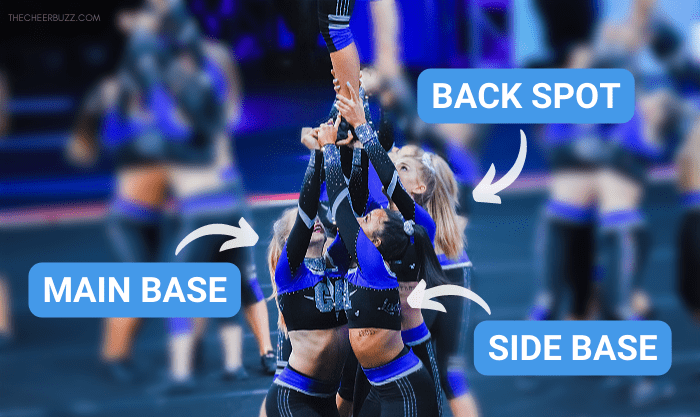
Main base
For one-legged stunts, the main base typically holds the toe and heel of the flyer. The main base is typically directly underneath the foot, giving as much stability as possible.
Some stunts require releasing and catching the flyer’s feet, like a full up for example. Depending on the team’s level, the main base may be required to hold on to the flyer’s foot during the spin.
Watch the video below for some releasing and twisting examples. From level 3 and higher, you can see main bases holding on to the foot the entire spin:
Secondary/side base
In one-legged stunts, the side base is responsible for the middle part of the foot, between the main base’s hands.
There are different types of side base grips for this type of stunt. Examples include having both hands underneath the foot, one hand underneath and the other over, or one under and the other supporting the main base.
As mentioned above for main bases, some stunts may require releasing and catching the flyer’s feet. This usually means the side base needs to let go of the foot completely and then catch it again.
Watch the video above for some examples of side bases releasing and catching the foot.
Flyer
A flyer is the person being lifted or thrown in a stunt.
The role of a flyer is to stay as tight as possible and often to perform different types of skills in the air. These types of skills can include twists, flips, and more depending on the team’s level.
Other than staying tight, flexibility is one of the most important things for flyers.
Because body positions help increase a team’s stunt score, flyers need to be able to correctly perform these.
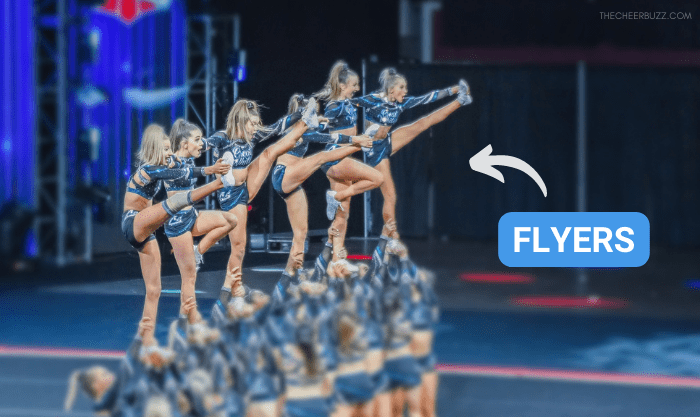
Speaking of flyer’s body positions, do you know some of the more uncommon ones? Take a look at our list here:
Back spot
A back spot is the person behind a stunt, typically holding (and lifting) the ankles, calves, or waist of the flyer.
The role of a back spot is, like bases, to lift, throw, and catch the flyer. Back spots are therefore also responsible for holding the stunt as stable as possible.
When catching a flyer, the back spot typically catches the shoulders and head – which is a crucial job!
Front spots
A front spot is someone who is placed in front of the stunt. Front spots will typically help catch the flyer, and provide additional support and extra strength in basket tosses for example.
This stunt position is rarer to see, simply because they are not required according to the rules. But don’t let that fool you – being a front spot is still a demanding and important job!
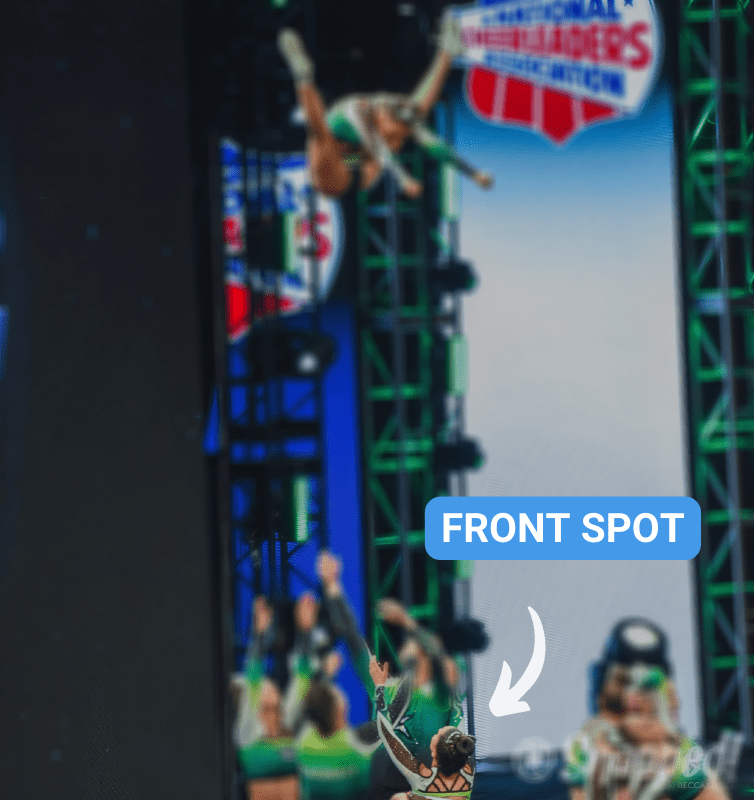
Additional spotters
Another position you might not see as often is additional spotters. Seeing additional spotters is more common on higher levels, where stunts may only have one base.
This person typically stands next to a stunt, ready to help if the stunt is shaky or on its way to falling.
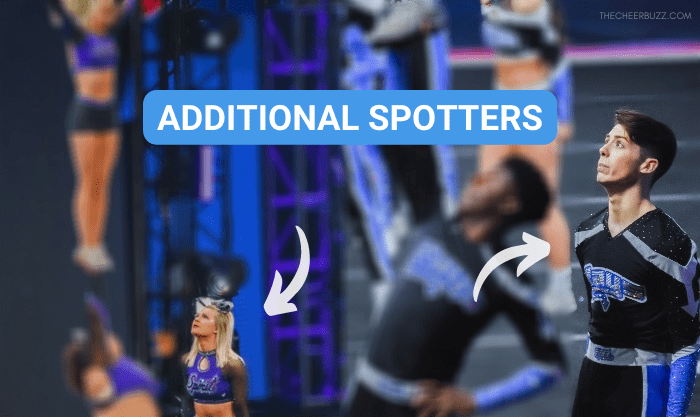
We hope this quick guide helped you understand the different stunt positions better! If you’d like to learn more about Allstar cheerleading, check out some of our other guides:
- The Cheerleading Level 1-7 System Explained – Skill Types & Differences
- What Is a BB, AF and Major BF in Cheerleading? + 6 More Deductions
If you want to stay updated on the sport, consider subscribing to our (free) weekly newsletter. Every Monday, we send one talking about the latest news & happenings in the sport!

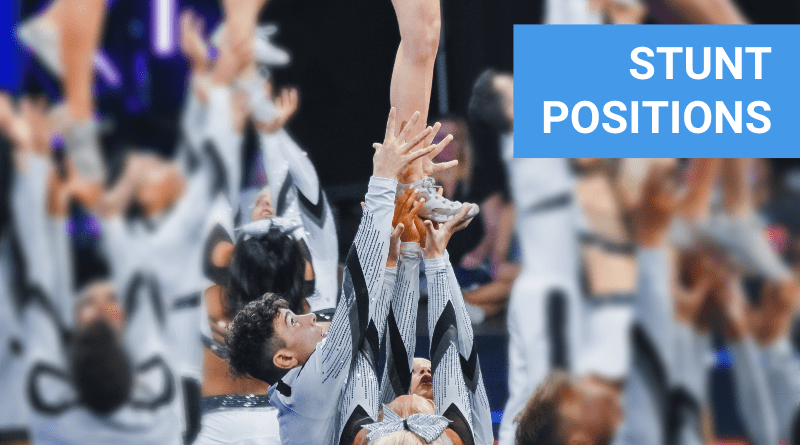
1 comment
Why is there a picture of James Charles in the Cheer-leading twisting stunts YouTube vid?